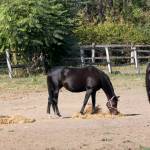Seeking Sweet Success: Using the Oral Sugar Test for Insulin Dysregulation in Horses

Researchers at the Royal Veterinary College performed a study to pinpoint the most reliable oral sugar test (OST) protocol for diagnosing insulin dysregulation, a key component of equine metabolic syndrome. Being able to consistently identify insulin dysregulation early in the course of disease will help detect horses at risk of laminitis.
The OST is a dynamic test that measures horses’ insulin levels before and after orally administered nonstructural carbohydrates (easily digested sugars, usually corn syrup). In other words, it mimics the natural physiologic process of consuming feedstuffs that contain sugar.
“As a horse digests its meal, sugar is absorbed into the bloodstream. This triggers the pancreas to release insulin which, in turn, signals various tissues throughout the body to absorb the circulating sugar,” explained Catherine Whitehouse, M.S., a Kentucky Equine Research nutritionist.
“In horses with insulin dysregulation, resting levels of insulin may be higher than normal or the amount of insulin released from the pancreas after a meal can be exaggerated. Over time, higher insulin levels, referred to as hyperinsulinemia, are capable of triggering bouts of laminitis, a life-threatening condition in horses.”
This abnormal insulin response to sugary meals explains why nutritionists like Whitehouse recommend diets low in nonstructural carbohydrates (NSCs).
“Feedstuffs with low NSCs help minimize post-feeding increases in blood glucose and insulin. Forages with less than 10% NSC (measured as starch plus water-soluble carbohydrates on a dry matter basis) are best for these horses combined with an appropriate concentrate feed or vitamin and mineral supplement,” advised Whitehouse.
Other important factors to consider, beyond just the percent of NSCs in feeds, are feeding rate, meal size, rate of intake, and digestibility of the feeds, according to Whitehouse.
On its face, the OST appears to be a straightforward test for veterinarians. A blood sample is obtained immediately before administering light corn syrup at a rate of 0.15 mL/kg body weight (approximately 165 mL for a standard 1,100-lb or 500-kg horse) using a standard dosing syringe. Horses are held off feed for one hour, at which point a second blood sample is collected. The amount of insulin in each sample is measured. If the basal insulin level in the first sample is equal to or greater than 30 IU/mL and/or the 60-minute post OST insulin level is 45-65 IU/mL or higher, then the horse is considered insulin dysregulation.
As easy as this test protocol sounds, many factors can skew the results, making it difficult to achieve a clear diagnosis of insulin dysregulation. Examples include:
- Time of day and season that the test is performed (hormone levels naturally fluctuate);
- Horse-to-horse variability;
- Insulin assay being used (different laboratories can yield different results);
- Dose of corn syrup used; and
- Whether the horse was fed or fasted prior to the study.
While some complicating factors cannot be controlled, dose of syrup and feeding/fasting state can. Some veterinarians suggest that a higher sugar level is needed to perform the test, up to 0.45 mL/kg, and that horses should be fasted prior to performing the test.
Considering the importance of the OST in identifying horses at risk of laminitis, one group of veterinary researchers recruited 21 horses to help optimize the OST protocol. In the first part of the study, horses were given a low dose (0.15 mL/kg) or high dose (0.45 mL/kg) of light corn syrup. In the second part, horses were administered the low-dose OST after being allowed pasture access up to the time of the test or after a three-hour fast.
This study found that the low-dose syrup could adequately identify insulin dysregulation in either fed or fasted horses.
“That said, both the low- and high-dose OSTs would have failed to diagnose some horses with insulin dysregulation. In this study, eight horses were previously diagnosed with insulin resistance, but a few of these were not found to be abnormal in this study. Therefore, further research is still needed to fine-tune this important test,” Whitehouse explained.
*Jocelyn, N.A., P.A. Harris, and N.J. Menzies-Gow. 2018. Effect of varying the dose of corn syrup on the insulin and glucose response to the oral sugar test. Equine Veterinary Journal 50(6):836-841.








